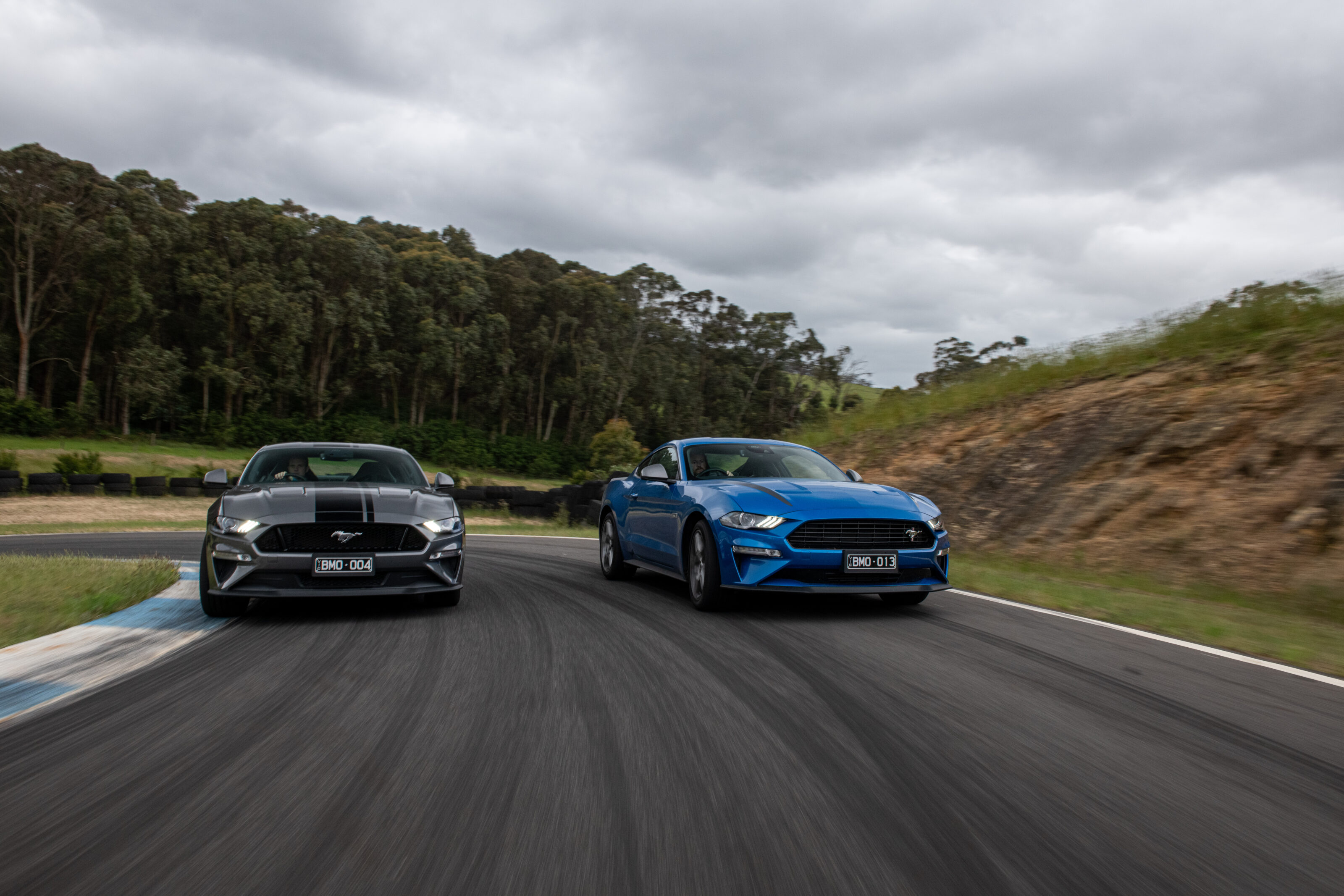I’ve only myself to blame, really. Following a track outing in ‘my’ Ford Mustang 2.3 High Performance long-termer last year, I proudly proclaimed that I believed it the pick of the non-Shelby litter for track use. While I’m not looking to make excuses, the caveat is that this was before the local introduction of the Mach 1, but his Enright-ness rightly called me out on the claim: “Ok Scotty, prove it”. If I must.
This is how we come to be present at Bryant Park hillclimb circuit with a Ford Mustang 2.3 High Performance, a Mustang V8 GT and a DriftBox with which to record the cold, hard data. But this test isn’t purely about numbers; driving enjoyment is an equally valid way to determine an order of preference. Can the lighter, less powerful four-pot pony make a case for itself?
There are many good things about Bryant Park, but one is the fact that its twisting, undulating layout tends to, if not negate any power advantage, then at least render it less relevant than at a more traditional track. This is important as on paper the V8-powered GT is significantly superior when it comes to under-bonnet urge.

With the upgrades included as part of the MY18 facelift – dual injectors, plasma bore liners, larger intake and exhaust manifolds – outputs leapt to 339kW at 7500rpm and 556Nm at 4600rpm. It’s at its most potent when paired with the optional 10-speed automatic fitted here, though our test car does without the MagneRide adaptive dampers.
What Aussie V8 Mustangs do have is some choice gear from the US Performance package, namely staggered rolling stock – 19.0 x 9.0-inch fronts with 255/40 tyres and 19.0 x 9.5-inch rears with 275/40s – and monster front brakes, the discs 380mm in diameter with six-piston Brembo calipers.
In chassis terms the 2.3 High Performance essentially mirrors the standard US-spec V8 GT. This means 19.0 x 9.0-inch rims all ’round shod with Pirelli P Zeros rather than Michelin Pilot Sport 4 S tyres and 352mm front brake rotors with four-piston calipers. Local cars also score half the optional ‘EcoBoost Handling Package’, which consists of a shorter 3.55:1 diff ratio (matching the V8’s) and thicker anti-roll bars front and rear.
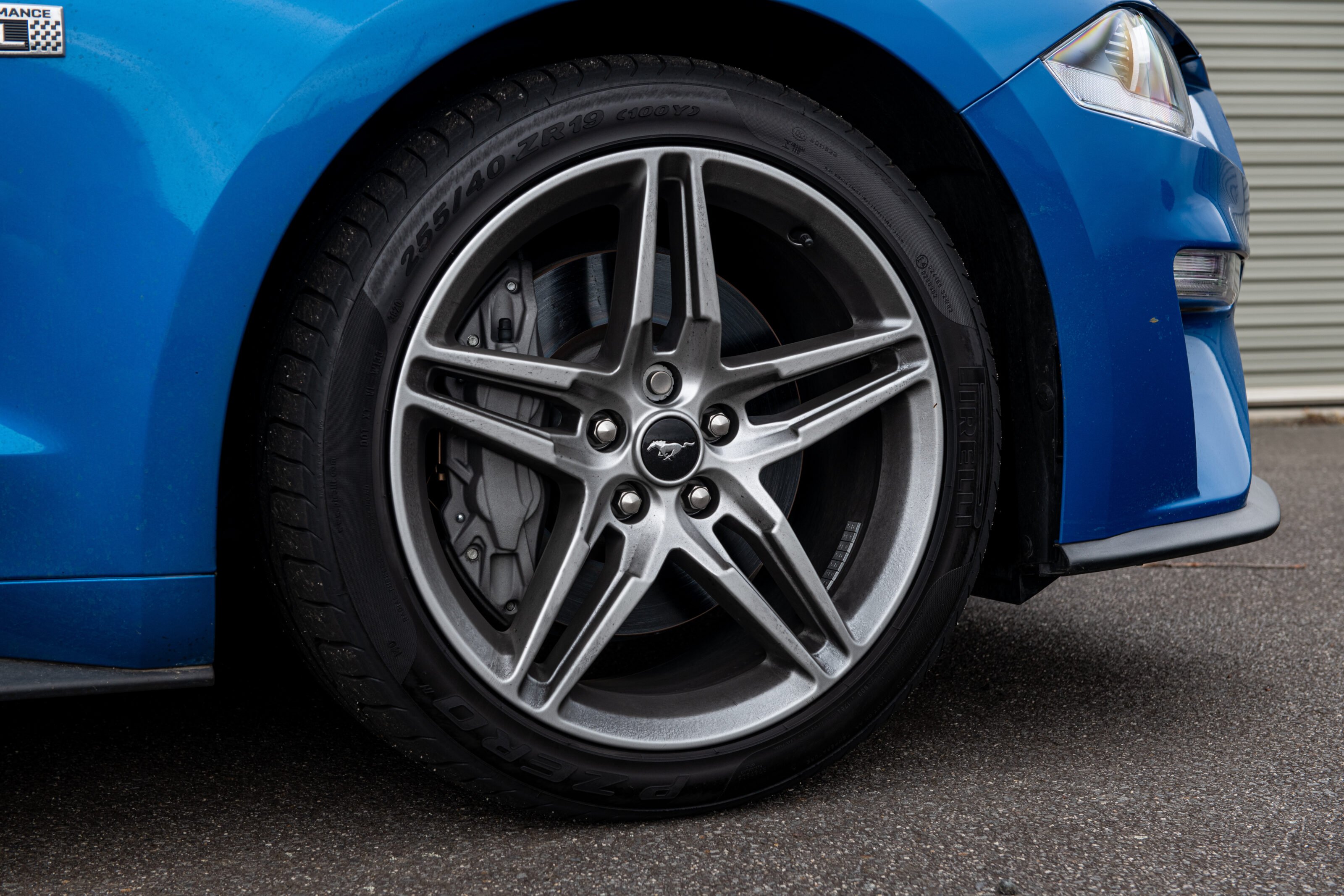
The manual would be our preferred transmission, the ratios in the Getrag ’box working much better in the HP than the GT, but to keep things even our test car is fitted with a 10-speed automatic, though it does have the advantage of MagneRide shocks.
On the spec sheet it looks like Ford’s engineers merely had a quick fiddle with the Mustang EcoBoost’s engine management system to extract an extra 12kW and 7Nm, but the changes run deeper than that. A drop in compression ratio from 9.5 to 9.37:1 allowed the fitment of a 5 per cent larger turbo so while peak outputs aren’t much higher, the power band has been extended in both directions. Maximum power now arrives at 6200rpm instead of 5700rpm and there’s at least 400Nm available from 2500-5300rpm.
The upshot of this is a genuinely entertaining car. The old EcoBoost Mustang could feel a bit like a goldfish in an aquarium on track, with plenty of space in which to roam but with little idea of what to do with it all. It just didn’t have the grunt to feel particularly interesting. However, the High Performance definitely rectifies that. With more torque available more of the time, suddenly the throttle needs some management to prevent the rear end swinging wide.
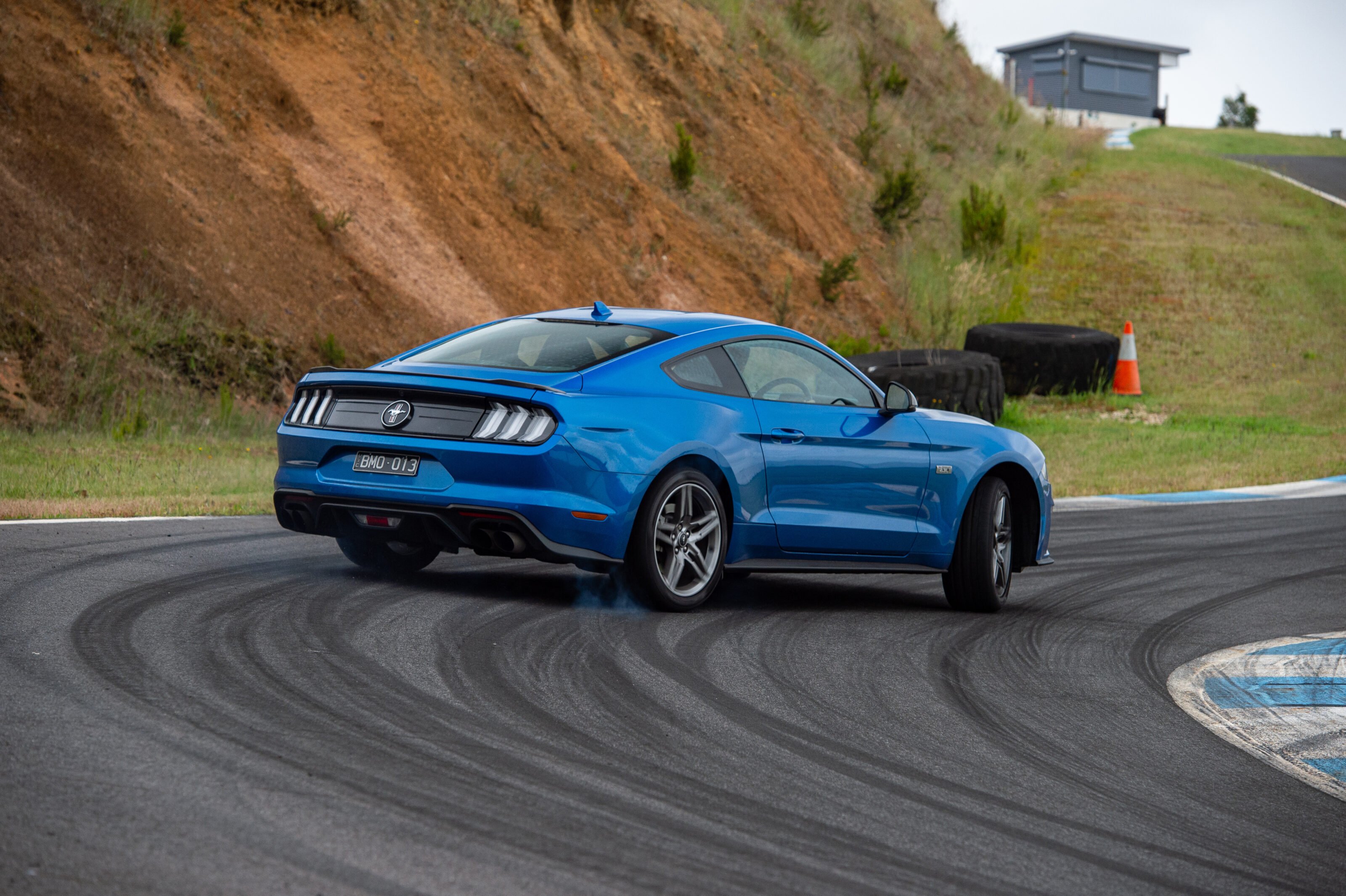
Not that it’s quite that easy. Even in four-cylinder form the Mustang is a heavy old thing at 1705kg (65kg lighter than the V8) and though setting the drive mode selector set to Track stiffens up the adaptive dampers there’s plenty of body movement. It’s not a car that likes to be hustled, feeling clumsy if you attempt to do so, and there is a slight understeer bias to the handling, but there are also plenty of positives.
Grip levels are reasonably high, the steering is accurate if not hugely communicative, the brakes hold up well and the chassis has impressive balance. You can commit to corners with confidence, safe in the knowledge that the worst case scenario is the gentle understeer mentioned a moment ago. The 10-speed automatic isn’t super keen on downshifting into second, but such is the torque available third feels no slower and that’s where it remains for the entire lap.
Subjective assessment is one thing, but the stopwatch never lies (not insinuating that journalists do, of course). Nor does it need to in this instance, as the Mustang 2.3 High Performance is very quick around Bryant Park. It records a best lap of 1min7.8sec, peaking at 120.28km/h on the back straight.
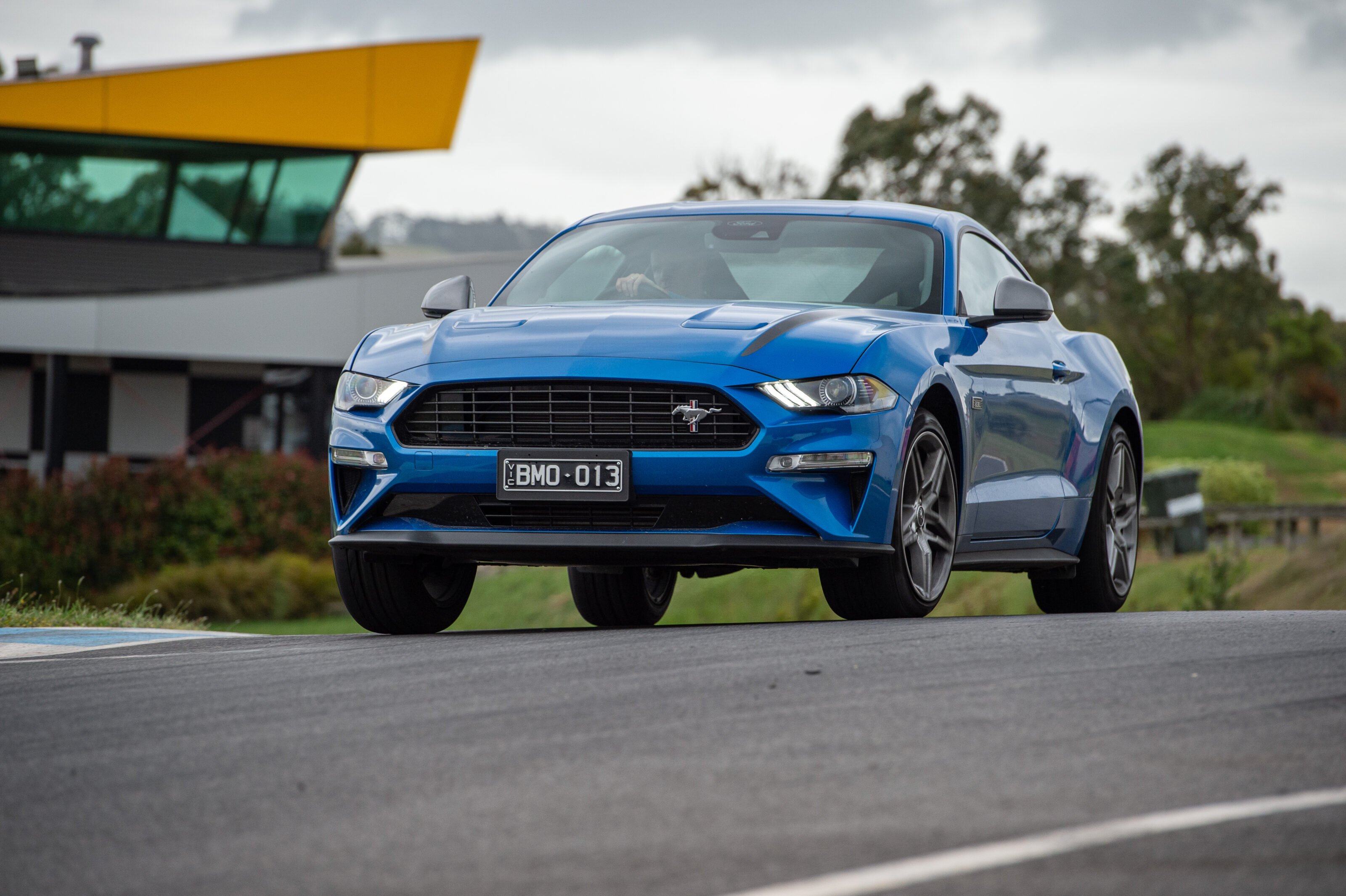
To provide some context, we’ve now run a number of cars on the same figure-eight course layout as part of MOTOR’s Track Series on YouTube (go and check it out!) and this four-cylinder Mustang is a second quicker than the latest i30 N DCT and just a second slower than the likes of the Audi RS5 and Lexus RC F Track Edition. Impressive.
At this point I’m honestly feeling pretty smug. The 2.3 High Performance is plenty enjoyable and given the company it’s in it’s hard to see the V8 GT improving on that lap time by much, if at all. From an experiential standout, however, those four extra cylinders do make a big difference. For all its improvements, the HP’s 2.3-litre turbo four-pot is certainly no musical instrument, whereas you could sell tickets to a Coyote V8 concert.
It’s a fantastic engine and the shorter nature of the Bryant Park circuit, in conjunction with cool ambient temperatures, means that the Mustang’s overheating problem doesn’t rear its head like it does at larger, longer tracks. I say overheating, but that conjures images of the family wagon spraying steam at the side of the road; instead this is more poor temperature control, the mercury quickly rising until the engine’s safeguards kick in, limiting revs and power.
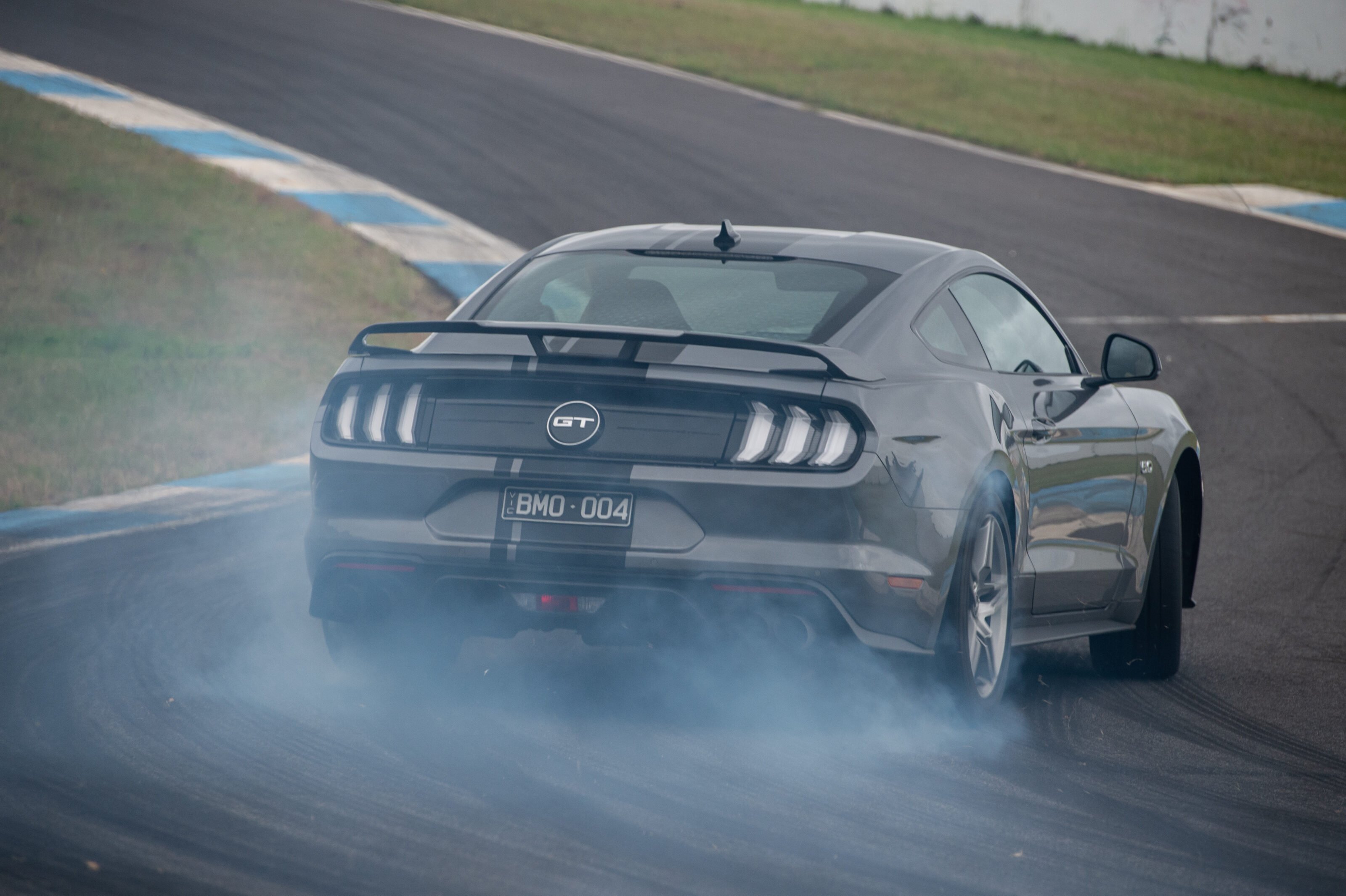
Even with all 339kW available, though, it’s not at all a handful. The passive suspension setup works well, the combination of Michelin rubber and wider rear tyres control the extra power and the engine’s linear power curve makes it a relatively simple process to keep things neat and tidy.
Another help is the Mustang’s excellent Sports ESP setting, common to both cars. While it’s deactivated completely for the timed laps, it’s extremely helpful when you’re learning a circuit or if the conditions turn sour, allowing enough slip to go fast but without unduly slowing you down.
Helmet on and stopwatch activated once again, a second and third glance is needed once we cross the finish line. A 1min5.5sec lap isn’t just 2.3sec quicker than the 2.3 HP, it’s the second quickest car we’ve lapped, just two-tenths slower than the Toyota Supra. It’s a remarkable result for a car that, while talented, isn’t necessarily renowned for its corner carving capabilities.
How did it do it? The data tells all. It would be easy to say that with 103kW/108Nm more of course the V8 would be faster, but it doesn’t tell the whole story. The power advantage certainly helps, the GT carrying an extra 8km/h into T1, 5km/h down the hill into T3, a whopping 9km/h over the crest between T8 and T9 and a huge 13km/h down the back straight. Every time there was an opportunity for the V8 to stretch its legs to gain time it did so, but was able to due to getting out of the preceding corners efficiently.
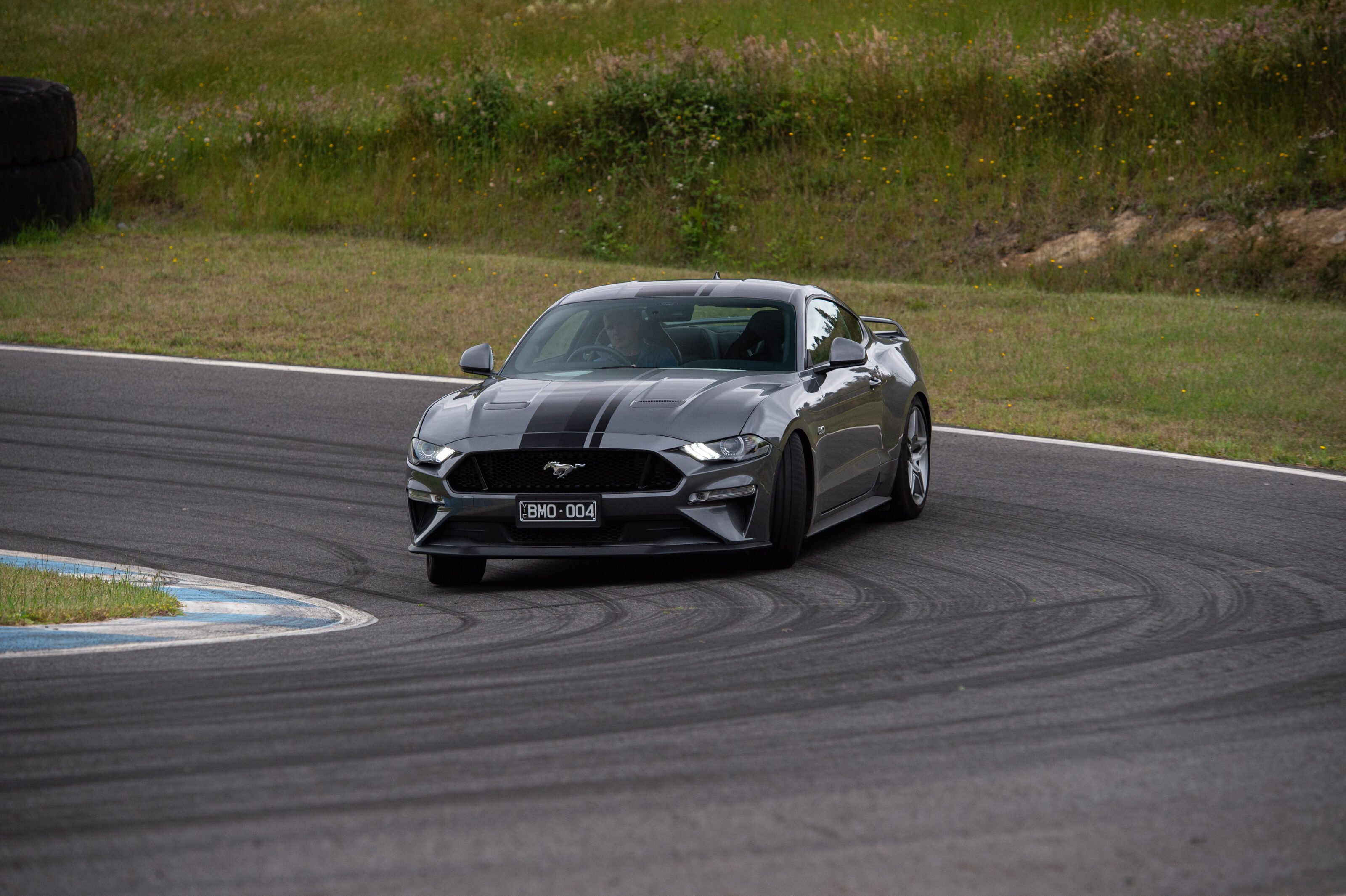
Time was also made in the corners, with the GT in general having higher minimum speeds, particularly in the faster bends at the beginning of the lap. Where the 2.3 HP did outperform its V8 sibling, it did so by a tiny margin, usually less than 1km/h, whereas the GT held a 4km/h advantage in T1, 2km/h in T2 and T5 and 4km/h once again in T6. It’s a pretty simple equation: the V8 is going through the corners just as quickly if not quicker, getting out of them more efficiently and then being quicker down all the straights.
So that’s it, a healthy helping of humble pie for me, then? Sort of. The Mustang GT is undoubtedly the superior performer in terms of raw numbers, but the elephant in the room is that on any regular track – Sandown, Winton, Phillip Island, The Bend – its cooling deficiencies will quickly curtail your enjoyment.
In our experience, the 2.3 HP has no such issues. It’s also still very enjoyable in its own right. If it wore anything other than a Mustang badge, a 236kW/448Nm turbocharged rear-wheel drive Ford coupe would be celebrated – modern-day Capri, anyone?
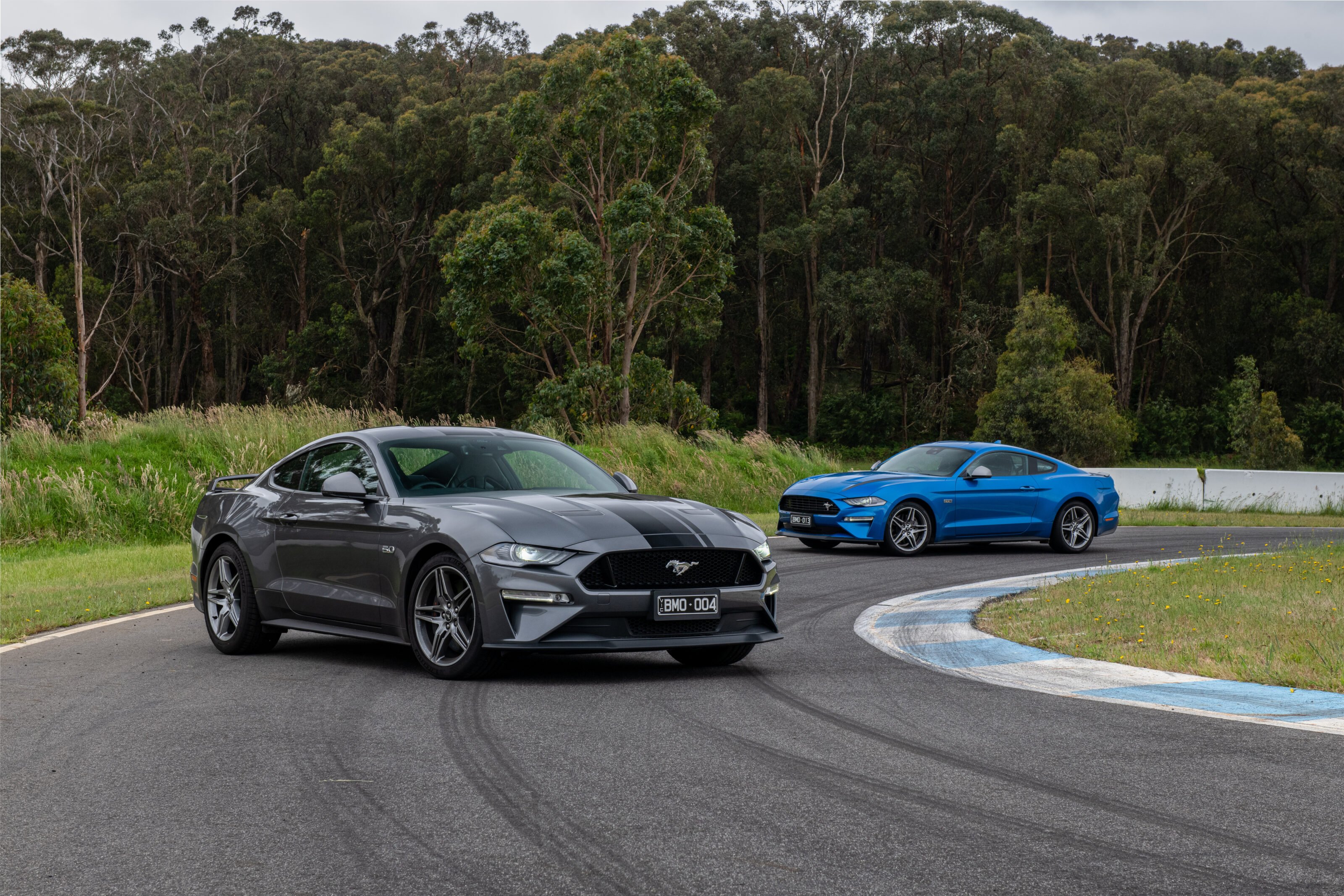
SCORING
Ford Mustang 2.3 HP
Things we like: Surprising dynamic talent; punchy four-cylinder turbo; ride quality
Not so much: Pairs better with the six-speed manual; it’s ultimately not a V8
VERDICT: 4/5
Ford Mustang GT
Things we like: Evocative soundtrack; isn’t lost at sea on track; deceptively fast
Not so much: Tall gearing in the manual; heat issues remain on longer tracks
VERDICT: 4/5
2022 Ford Mustang 2.3 HP specifications
| BODY: | 2-door, 2+2-seat coupe |
|---|---|
| DRIVE: | rear-wheel |
| ENGINE: | 2300cc inline-4cyl, DOHC, 16v, turbo |
| BORE X STROKE: | 87.6 x 94.0mm |
| COMPRESSION: | 9.4:1 |
| POWER: | 236kW @ 6000rpm |
| TORQUE: | 448Nm @ 3000rpm |
| POWER/WEIGHT: | 138kW/tonne |
| TRANSMISSION: | 10-speed automatic |
| WEIGHT: | 1705kg |
| SUSPENSION: | struts, adaptive dampers, anti-roll bar (f); multi-links, adaptive dampers, anti-roll bar (r) |
| L/W/H: | 4788/1915/1379mm |
| WHEELBASE: | 2720mm |
| TRACKS: | 1585/1654 (f/r) |
| STEERING: | electrically assisted rack-and-pinion |
| BRAKES: | 352mm ventilated discs, 4-piston calipers (f); 330mm ventilated discs, single-piston calipers (r) |
| WHEELS: | 19.0 x 9.0-inch (f/r) |
| TYRES: | 255/40 ZR20 (f/r) Pirelli P Zero |
| PRICE: | $54,490 |
2022 Ford Mustang GT specifications
| BODY: | 2-door, 2+2-seat coupe |
| DRIVE: | rear-wheel |
| ENGINE: | 5038cc V8, DOHC, 32v |
| BORE X STROKE: | 93.0 x 92.7mm |
| COMPRESSION: | 12.0:1 |
| POWER: | 339kW @ 7500rpm |
| TORQUE: | 556Nm @ 4600rpm |
| POWER/WEIGHT: | 191kW/tonne |
| TRANSMISSION: | 10-speed automatic |
| WEIGHT: | 1770kg |
| SUSPENSION: | struts, coil springs, anti-roll bar (f); multi-links, coil springs, anti-roll bar (r) |
| L/W/H: | 4788/1915/1379mm |
| WHEELBASE: | 2720mm |
| TRACKS: | 1585/1654 (f/r) |
| STEERING: | electrically assisted rack-and-pinion |
| BRAKES: | 380mm ventilated discs, 6-piston calipers (f); 320mm ventilated discs, single-piston calipers (r) |
| WHEELS: | 19.0 x 9.0-inch (f); 19.0 x 9.5-inch (r) |
| TYRES: | 255/40 ZR19 (f); 275/40 ZR19 (r) Michelin Pilot Sport 4 S |
| PRICE: | $66,690 |
We recommend
-
 News
NewsNew car calendar 2026: All the new cars coming to Australia next year
Here’s the WhichCar by Wheels guide to all the new cars that will launch in Australia in 2026. Check back in regularly for updates...
-
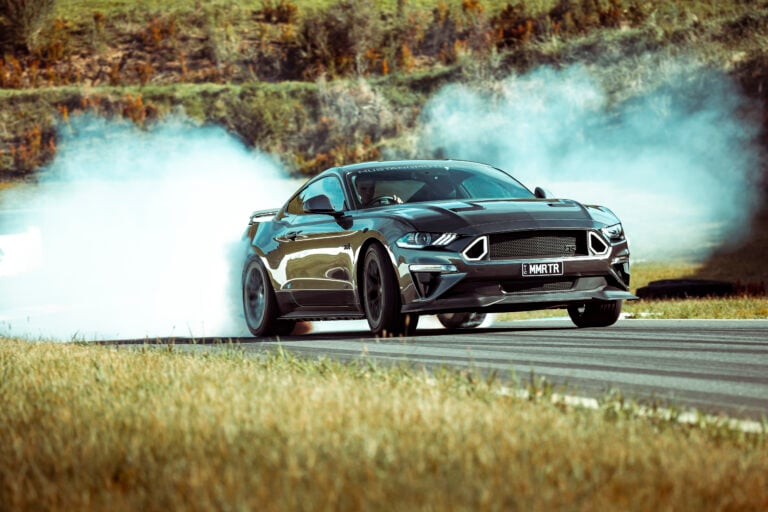 Reviews
Reviews2021 RTR Ford Mustang review
To concentrate on the engine’s huge outputs alone misses the point as RTR's chassis modifications are the real highlight
-
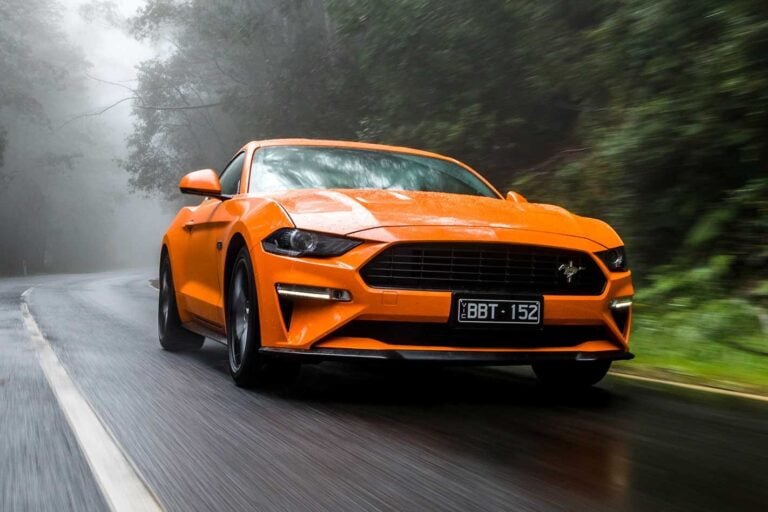 Reviews
Reviews2020 Ford Mustang 2.3L High Performance review
Turbo 236kW four-banger no modern day Nissan 200SX


